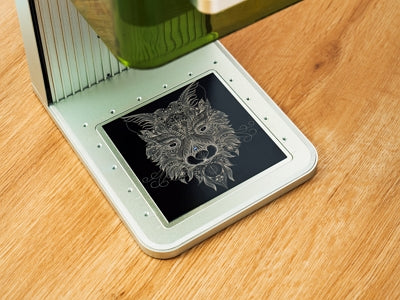In the laser engraving community, the comparison between fiber laser engravers and infrared (IR) laser engravers often creates confusion. Many people, including users of laser engravers, mistakenly believe that these two types of lasers are identical. However, understanding the differences between a fiber laser and an infrared(IR) laser is crucial when deciding which laser engraver is suitable for engraving metals, plastics, and other hard materials.
This article provides a comprehensive overview of fiber lasers and infrared lasers, delving into their working principles, similarities, differences, and applications. With this knowledge, you will be better equipped to make an informed decision when choosing the right laser engraver for your specific needs.
What is a Fiber Laser & How Does a Fiber Laser Work?
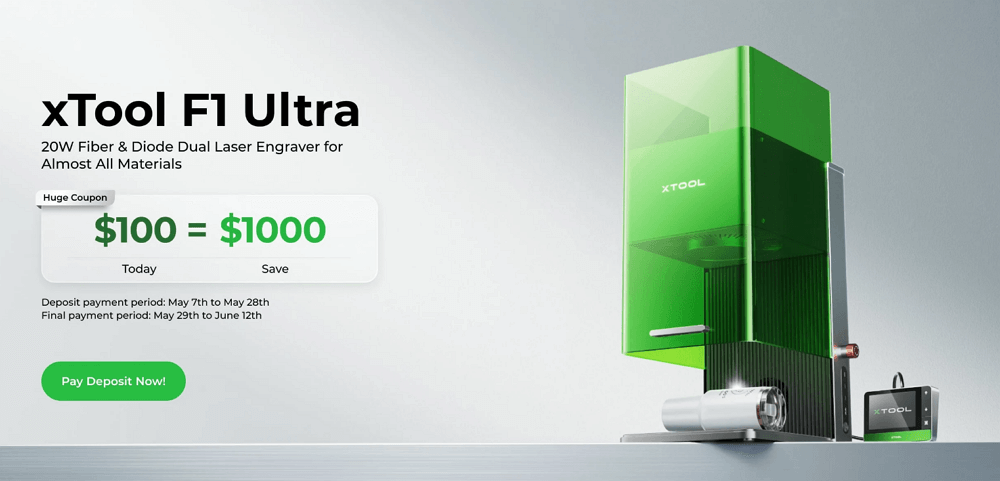
A fiber laser is a type of solid-state laser that utilizes laser diodes as its light source for generating laser beams. The light is directed through a fiber-optic cable, giving this laser its name—fiber laser.
The key component of a fiber laser is the fiber optic cable, which distinguishes it from other laser types and is responsible for its unique characteristics, features, and performance. To understand the working of fiber lasers, we must delve into the details of the fiber optic cable.
Examining the cross-section of a fiber-optic cable reveals an outer cladding, an inner cladding, and a core of silica glass doped with a rare-earth element at the center. The core is selectively doped, and the doping element varies depending on the fiber laser's application, determining the output laser beam's final wavelength.

The generated light enters the doped core, where the claddings reflect any light that deviates from its intended path, ensuring optimal direction. The light then passes through a specialized convex lens called Bragg gratings, which converges the light into a powerful laser beam. Subsequently, the beam goes through an oscillator to enhance coherence before being outputted. Once the laser beam falls on an object, it is ready to perform its designated task.

What is an Infrared (IR) Laser & How Does an Infrared Laser Work?
What we commonly refer to as infrared lasers are lasers with a wavelength of 1064nm. Like fiber lasers, they're also a solid-state laser that uses laser diodes to generate light. However, unlike fiber lasers, it does not employ optical fibers as the gain medium.
Infrared(IR) lasers are named as such because the emitted light's wavelength falls within the infrared spectrum, ranging from 700nm to 1mm (1,000,000nm). Since the laser beam is within the infrared region, it is invisible to the human eye and has no discernable color.
Fiber Lasers vs Infrared(IR) Lasers: Differences & Similarities
The main distinctions between infrared and fiber lasers lie in their construction, working mechanisms, wavelength, power, performance, speed, size, and price.
1. Working Mechanism and Construction
In terms of construction and working mechanisms, infrared lasers are simpler. Fiber lasers, on the other hand, have a more complex construction, utilizing special optical fibers made from rare-earth elements.
2. Wavelength
While fiber lasers can have varying wavelengths depending on the doped element used (e.g., ytterbium, neodymium, erbium, holmium), infrared lasers have a fixed wavelength of 1064 nm. If you need a fiber laser engraver of 1064nm, then you need to use ytterbium as the doped material. For 780-1100nm, neodymium is used. Other commonly doped materials are:
- praseodymium: wavelength = 1300nm
- erbium: wavelength = 1462-1640nm
- thulium: wavelength = 1900+nm
- holmium: wavelength = 2025-2200nm
- dysprosium: wavelength = 2600-3400nm
With that being said, the wavelength of a fiber laser is not limited to 1064nm; it can be more or less but is always in the infrared region of light. However, the most-used wavelength in fiber lasers on the market is 1064nm. On the other hand, the wavelength of Infrared(IR) lasers is 1064 nm, which cannot be changed.
3. Laser Power
Fiber lasers boast significantly higher power than infrared lasers, with optical power ranging from 20W to several hundred watts or more.
Secondly, the peak power of fiber lasers is very high. Even if the optical power of the machine is 50-100 watts, the peak power can reach over 10,000 watts. It is because fiber lasers can also work in the pulsed operation mode that offers pulses of very intense energy. Thus, fiber lasers can engrave and cut hard materials, such as metals, without any hassle.

Infrared(IR) lasers have a common power range of 1-2W, but their peak power can reach up to 15,000 watts, making them capable of marking on metals as well.
4. Performance and Speed
When it comes to performance and speed, both fiber and infrared lasers excel, depending on their power rating. Fiber lasers offer faster engraving and cutting due to their immense power and high peak power, while infrared lasers work at a slightly slower pace but still deliver impressive results.
5. Machine Size
In terms of size, fiber laser engravers are typically 3-10 times larger than infrared laser engravers, making them unsuitable for home or small spaces. In contrast, infrared laser engravers can come in compact and small sizes.

In conclusion, both fiber and infrared laser engravers are suitable for small business. However, choose a fiber laser engraver if you need to achieve deep engraving on metal.
Fiber Lasers vs Infrared(IR) Lasers: Applications
Choosing between a fiber laser engraver and an infrared(IR) laser engraver depends on the specific application. Here are some common laser applications and the recommended laser type for each:
1. Jewelry Engraving
Both fiber and infrared lasers are excellent choices for engraving metal jewelry. However, choose a fiber laser if you need deep engraving.

2. Plastic Engraving
Both fiber and infrared lasers deliver premium results when engraving plastic or acrylic, as the engravings are clearly visible.

3. Metal Cutting
For cutting metal sheets up to 0.05mm, a suitable infrared laser engraver can be used, but not all machines are capable of doing so. For thicker metals, a fiber laser engraver specifically designed for laser cutting metals is required.
4. Laser Welding
A fiber laser welder is the best option for laser welding, as they provide clean, quick, and precise welds that are difficult to achieve using other methods and technologies.
5. Laser Cleaning
Fiber laser cleaning machines are ideal for industrial-grade laser cleaning. They can remove rust, paint, and other unwanted substances from surfaces.
2 Best Infrared(IR) Laser Engravers for Sale
1. xTool F1: The Fastest Portable Infrared Laser Engraver
If you're looking for the fastest portable infrared laser engraver on the market, the xTool F1 is the perfect choice. Combining exceptional speed, precision, and portability, this innovative infrared laser engraver offers users a truly versatile and efficient engraving solution. Here are the standout features that make the xTool F1 the best and fastest portable infrared laser engraver:
1. Advanced Infrared Laser Capabilities
The xTool F1 features a 2W 1064nm infrared laser, making it ideal for engraving most common metals and plastics, including gold, silver, platinum, copper, aluminum, iron, stainless steel and more. Its 2-in-1 design, which also includes a 10W 455nm diode laser, allows for engraving on over 300 types of materials, including wood, acrylic, glass, leather, ceramic and more, greatly expanding creative possibilities.


2. Unparalleled Speed and Precision
Thanks to advanced industrial-grade galvanometer technology, the xTool F1 boasts engraving speeds that rival powerful fiber lasers, reaching up to 4,000m/s. This incredible speed significantly reduces engraving time, boosting productivity. Moreover, its 0.00199mm accuracy ensures flawless results on a wide range of materials.

3. Portability and Mutiple Ways of Engraving
The xTool F1 is designed with portability in mind. Its compact size and handheld design allow for easy transport and engraving on various objects, regardless of size and angle. Additionally, the device can be used on a table or desktop, offering the versatility of both handheld and desktop engraving. The xTool F1 is also compatible with the RA2 Pro, a 4-in-1 rotary attachment that allows for engraving on 90% of irregular objects. With this attachment, users can easily engrave cylindrical and spherical items, such as mugs, rings, and spheres. The adjustable cover ensures that the attachment does not interfere with the engraving area, providing even more versatility and creative possibilities.

The user-friendly xTool Creative Space software is compatible with Windows, macOS, iPadOS, iOS, and Android, making it simple to process engravings even on a mobile device.

4. Live Engraving Preview and Ease of Use
With the xTool F1's auto-focus technology, users only need to input the material thickness, then the laser module will automatically find the focus, avoiding tedious manual focusing process.
Additionally, through the live preview technology, users can easily position graphics on the object, ensuring perfect results without wasting materials. Frame and graph outline previews provide an accurate view of the engraving placement, allowing for adjustments before the process begins.


5. Unique Engraving Opportunities
As the fastest portable infrared laser engraver, the xTool F1 is perfect for engraving unique signs, personalized gifts, and customized merchandise for customers. Its speed and precision ensure that every piece is expertly engraved, creating lasting memories and value for clients.

6. Mobile Business Opportunities
With the xTool F1's portability, users can easily take their engraving business on the go. This compact laser machine can be brought to craft shows, fairs, parties, or other events, offering live engraving services that are both safe and smoke-free. This ability to perform fast, precise engraving in front of an audience is sure to impress potential customers and generate interest in your services.

7. Safety Features
The xTool F1 is designed with user safety in mind. The laser is fully enclosed, preventing accidental exposure to laser beams and debris. A built-in exhaust with a high-speed fan and an air purifier effectively remove smoke and smell from the engraving area, enabling safe indoor use without causing pollution.
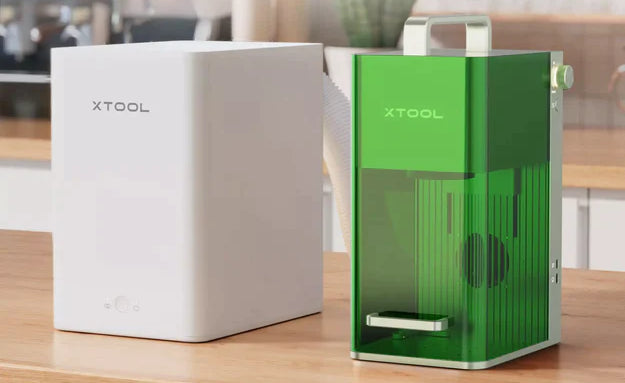

8. Extended Working Area
With the silde extension, its working area is increased fourfold, allowing you to engrave and cut longer objects and perform batch processing.

2. xTool D1 Pro 2-in-1 Kit
If you're in search of a desktop infrared laser engraver that offers a larger engraving area, the xTool D1 Pro 2-in-1 kit is the perfect choice. This remarkable machine is also equipped with both a blue diode laser and an infrared laser, allowing you to engrave and cut a wide range of materials with precision and ease.
1. Large Desktop Engraving Area
The xTool D1 Pro 2-in-1 kit features an desktop design that provides a spacious working area of 430 x 390mm. This generous size, which can be further expanded using an extension, sets it apart from the most handheld laser engravers on the market, offering you the flexibility to work on larger projects and materials.
2. High-Powered Infrared Laser
The combination of blue and infrared lasers enables you to work with materials such as wood, plywood, acrylic, glass, ceramic, rock, plastic, and various metals. With the optional 20W blue laser module, you can even perform color engraving on metals. The 2W infrared laser boasts a peak power of up to 15,000W, allowing you to engrave hard materials like metals and plastics with ease. Its fine laser spot measuring only 0.03 x 0.03mm ensures precise and detailed engraving results.

3. Upgradable
The xTool D1 Pro 2-in-1 kit is designed for future upgrades, allowing you to attach both laser modules and purchase separate 5W or 10W blue laser modules for enhanced engraving capabilities. Numerous accessories, such as an extension for engraving larger objects, a rotary attachment for spherical and cylindrical objects, and air assist for improved engraving results, are available to adapt the machine to your specific needs.

4. High-Speed Engraving and Cutting
With a maximum speed of up to 400mm/s, the xTool D1 Pro 2-in-1 kit delivers outstanding engraving and cutting performance. Its robust construction, featuring steel shafts and wheels, ensures durability and longevity that outlasts other machines on the market.

5. Advanced Features and Functionality
The xTool D1 Pro 2-in-1 kit also includes various notable features, such as limit switches for accurate laser module positioning, flame detector, tip-over safety, specialized software, and more, to elevate your laser engraving and cutting business to new heights.
Note: If you already own an xTool D1 Pro, you can purchase the 1064 nm infrared laser module separately to upgrade your existing machine.
3 Best Fiber Laser Engravers for Sale
1. FSL Muse 1064nm Fiber Galvo Laser Engraver

image credit: FSL Muse
The FSL Muse 1064nm Fiber Laser Engraver is a highly potent machine capable of engraving a wide range of hard materials, including metals, polymers, leather, and stones. Equipped with remarkable features, this machine simplifies the laser engraving process. Its 3D camera visualizes the object and its dimensions, automatically adjusting the laser's focus for optimal engraving. Its software is compatible with popular operating systems, and the machine also features a dedicated large LCD panel for direct control. With a working area adjustable from 4 x 4 inches to 12 x 12 inches and a maximum height of 412mm, this engraver accommodates various project sizes.
Available in 20W, 30W, and 50W options, this 320lb machine is ideal for industrial applications or high-level laser engraving and cutting businesses rather than home use.
2. OMTech 30W Fiber Laser Engraver

image credit: OMTech
The OMTech 30W Fiber Laser Engraver is a powerful, heavy-duty machine with an impressive 7m/s engraving speed, capable of working on metals, plastic, leather, and other materials. Its adjustable pulse frequency allows for engraving a wide range of materials and achieving color engraving on various metals. With an accuracy of up to ±0.1 microns, the Sino-Galvo scanning head ensures intricate designs are executed precisely. The maximum engraving area is 175 x 175mm, and the red dot and built-in grids make object positioning effortless. This machine also includes a chuck rotary for engraving cylindrical and circular objects, making it an excellent choice for jewelers, industrial applications, and small businesses.
3. QS-20 LiteMarker 20W Fiber Laser Engraver

image credit: CLOUDRAY
The QS-20 LiteMarker 20W Fiber Laser Engraver is a compact, lightweight machine that requires less space than other fiber lasers. It can engrave various materials, including gold, aluminum, silver, copper, brass, steel, plastic, marble, stone, ceramic, and leather. With a working area of 110 x 110mm and a remarkable speed of 5,000mm/s, this machine is ideal for commercial purposes and small businesses. It excels at marking jewelry, customizing objects, creating barcodes, logos, and more. Boasting a position accuracy of ±0.1µm, the QS-20 LiteMarker fiber laser engraver provides precise engraving, and the easy-to-focus lens and red dot device ensure accurate object positioning. A separate rotary attachment can be purchased for engraving cylindrical and curved surfaces.
FAQs of Fiber Lasers and Infrared Lasers
1. What Materials Can a Fiber Laser Engrave or Mark?
Fiber lasers are particularly effective for engraving metals such as stainless steel, aluminum, brass, copper, gold, silver, titanium, and various alloys. Fiber laser engravers can also engrave some Non-Metal Materials such as Leather, Hard Plastics, etc.
2. Can You Engrave Wood with a Fiber Laser?
Fiber lasers are not ideal for engraving wood because they are specifically designed to work with metals and certain types of plastics. The wavelength of fiber lasers is not well-absorbed by wood, resulting in less efficient engraving and potential damage to the wood. Instead, a CO2 laser engraver is the preferred choice for engraving wood as they have a wavelength that is better absorbed by organic materials, like wood, acrylic, leather, and textiles.
3. Can a Fiber Laser Etch Glass?
Fiber lasers are not the best option for etching glass. They are primarily designed for engraving metals and certain types of plastics. For etching glass, CO2 lasers are a more suitable choice. Their longer wavelength is better absorbed by glass, resulting in precise and high-quality etching without causing cracks or other damage.
4. How Long will a Fiber Laser Last?
The lifespan of a fiber laser depends on several factors, such as the quality of the laser components, usage conditions, and proper maintenance. A key component of a fiber laser system is the laser diode, which serves as the source of the laser beam. High-quality laser diodes can last anywhere from 50,000 to 100,000 hours or more, which translates to many years of operation, even under heavy use. However, it's essential to ensure that the fiber laser system is well-maintained, kept clean, and operated within the recommended guidelines to maximize its lifespan. Additionally, the quality of the components used in the laser system and the reputation of the manufacturer can also impact the longevity of the laser.
Conclusion
We have discussed fiber laser vs infrared laser in detail. Now, you might have a very clear idea of these machines and what they are used for. You can look at their working principles, differences, and similarities to understand which laser engraver is the right one for your needs. We have also picked some of the best fiber laser engravers and infrared laser engravers that you can purchase from the market. These are exceptional products with distinct features. Make sure you check the specifications, features, and other characteristics before making any purchase.
Related Articles
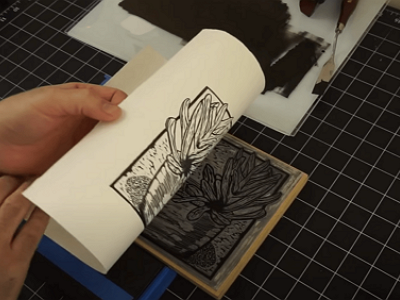
Block Printing for Beginners: How-To & DIY Ideas
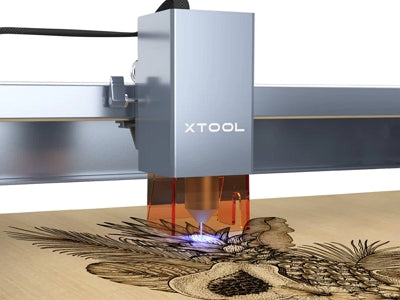
4 Types of Printmaking Techniques
